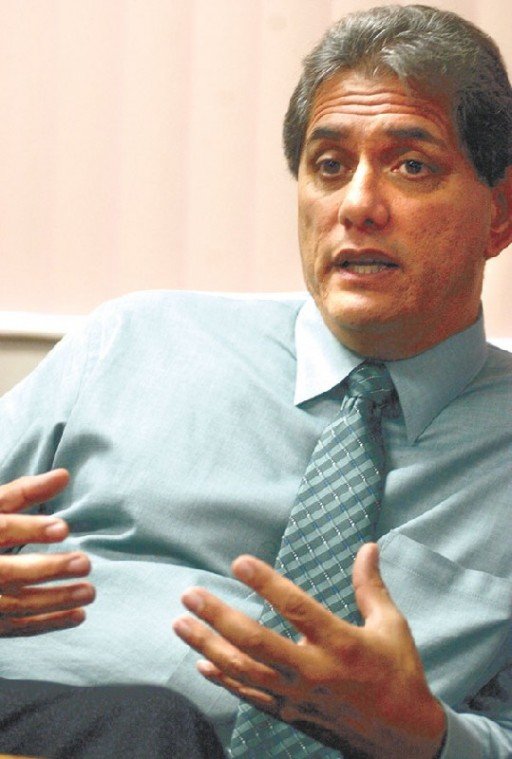Gilroy Unified School District’s superintendent has improved
performance, morale and accountability
Gilroy – Edwin Diaz didn’t exactly inherit a gem.
When Diaz returned to his hometown to serve as Gilroy Unified School District superintendent, student performance was poor and declining, parent involvement was low and there was genuine unrest among the staff.
“There was a lot of turmoil,” Diaz said, during a recent interview at the district office. “At the time, Gilroy was struggling.”
Before Diaz took over, the GUSD board was in the process of trying to oust David Alvarez, the former superintendent.
While searching for a new superintendent, Alvarez was literally in the chief’s seat, but in reality some board members were running the show, said Diaz.
The board had conducted a superintendent search, accepted applications and interviewed candidates, but they weren’t happy with the results. After some discussion, the board approached Diaz, who was serving as the assistant superintendent of the Oak Grove School District at the time, and asked him to apply for the position.
“And then I came back to Gilroy,” he said.
Because he grew up and was educated in Gilroy, Diaz said “there’s a high level of personal commitment to the district.”
Five years have passed since Diaz took hold of the GUSD reins, so what does he have to show for it?
Increasing student performance is his top priority and the superintendent does have some bragging rights in that area.
Academic Performance Index scores have improved under Diaz’s watch. Eleven of Gilroy’s 12 schools increased their 2004 API scores. In 2002, the district wide API base score was 643 compared to 681 in 2004.
But when minorities and the poor were factored in, only half of Gilroy’s schools met the API growth targets set by the state for 2004-2005. Also, Luigi Aprea Elementary School is the only local school that has managed to hit, and exceed, the statewide target of 800.
The API is based on the results of the Standardized Testing and Reporting program and the California High School Exit Exam. Scores can range from a low of 200 to a high of 1,000.
As the new superintendent Diaz noticed there wasn’t much communication between administrators and teachers, a fault he linked with the district’s low test scores. To remedy the situation Diaz made his face familiar, visiting classrooms at every site.
Through the visits, he learned that there was little staff development. Since then, GUSD has made a “major investment” in teacher training which has resulted in a “very well-trained staff,” said Diaz.
Diaz also discovered that there was little consistency in the district – that standards weren’t being implemented in every classroom. That’s one of the reasons the Accountability Task Force was developed in the fall of 2004.
The group, comprised of business leaders, parents, teachers, community members and district officials, meets about five times a year to define goals, discuss data and work to ensure that every student at each site an equal education and offered the same programs.
Teachers are meeting with principals and other teachers to discuss individual student progress and deficiencies. District officials and teachers stage study sessions to analyze test results and identify ways to move ahead.
Diaz also implemented the District Recognition Program, to ensure that district employees are honored for their accomplishments and hard work.
Another major change made under his leadership, was the move to neighborhood schools, said Diaz. Students now attend the school in their neighborhoods.
Under his watch, teacher salaries have improved. When he came on board, local teachers received the lowest salaries when compared to comparable districts. Now, GUSD teacher salaries are among the top five.
Gilroy High School’s low math scores is another sticky point. In general math on the 2005 California Standards Test – an exam based on sixth and seventh grade standards – only 6 percent of ninth-graders were ranked proficient or advanced.
In the algebra section, only 4 percent of freshmen and sophomores were proficient and 2 percent of juniors.
Those are the numbers that surface when locals hear about Diaz’s progress, and, most recently, his 25 percent raise.
The homegrown superintendent recently came under some fire when the board bumped up his annual salary to $175,000. Of the 221 locals who responded to a Dispatch poll, only 44 said that was an appropriate move.
GUSD board members pointed out that they were simply bringing his salary more in line with other local school districts. Even with the substantial raise, Diaz takes home less than Morgan Hill Unified School District’s superintendent who makes $185,000.
The board said he deserves the raise because he’s instituted some major changes in the district and improved student performance.
But that Diaz has made increasing student performance a top priority isn’t unique. Every school district, across the nation, is reaching in the same direction.
The question is, how is Diaz going to continue to bump up scores, particularly in math, where GUSD lags behind?
To district is looking at hiring additional math teachers for fourth and fifth-graders, since scores tend to drop after the third grade with the goal to attack at an early age, before the deficiencies manifest.
They’re also looking into offering after school and Saturday math academies. Beefing up the time middle school students spend in math class – currently it’s about 45 minutes – is also on the agenda.
Basically, teachers and administrators need to pull together to improve student performance and find out the individual needs of each student, Diaz said.
Diaz has made some improvements but the district still has a long way to go, said Gilroy Teachers Association President Michelle Nelson.
Nelson said she was pleased when Diaz returned to GUSD because she’d worked with him before and that teacher morale has improved somewhat.
“In general the workload has increased everywhere and the job is much harder and it has changed considerably since I started in 1980 because of the state and federal mandates,” she said. “It’s just a more demanding job than it was before.”
Nelson said she’s not happy with the district’s response to state and federal mandates and how they chose to bring them to the district level.
And, Nelson wasn’t happy to hear about Diaz’s salary increase. After learning of the raise, Nelson e-mailed board members and Diaz telling them from a public relations’ stance it wasn’t a good move.
“What kind of bothers me about the raise is the amount,” she said.
If Diaz had received a 4.5 percent raise like the other employee groups that would have been fair, said Nelson.
Nelson said she would also like to see the fog cleared up that currently chokes up the lines of communication from the district to school sites.
Trustee Pat Midtgaard thinks the board has not clearly communicated Diaz’s goals and progress to the community. The board will outline the superintendent’s goals at the Dec. 8 board meeting.
Superintendent Diaz-by the Numbers
6th year as Gilroy Unified School District superintendent
175 thousand dollars, annual salary
11 schools improved thier 2004 API scores under his watch
Accomplishments
– Improved community involvement and district accountability: Helped assembly committees such as the Accountability Task Force, Student Wellness Policy Committee, Gilroy High School Bell Schedule Study Group and Facilities
Oversight Committee.
– Improved student performance: In 2002, the districtwide API base score was 643 compared
to 681 in 2004.
– Improved staff morale: More input and participation from teachers and implementation of
District Recognition Program at board meetings.















